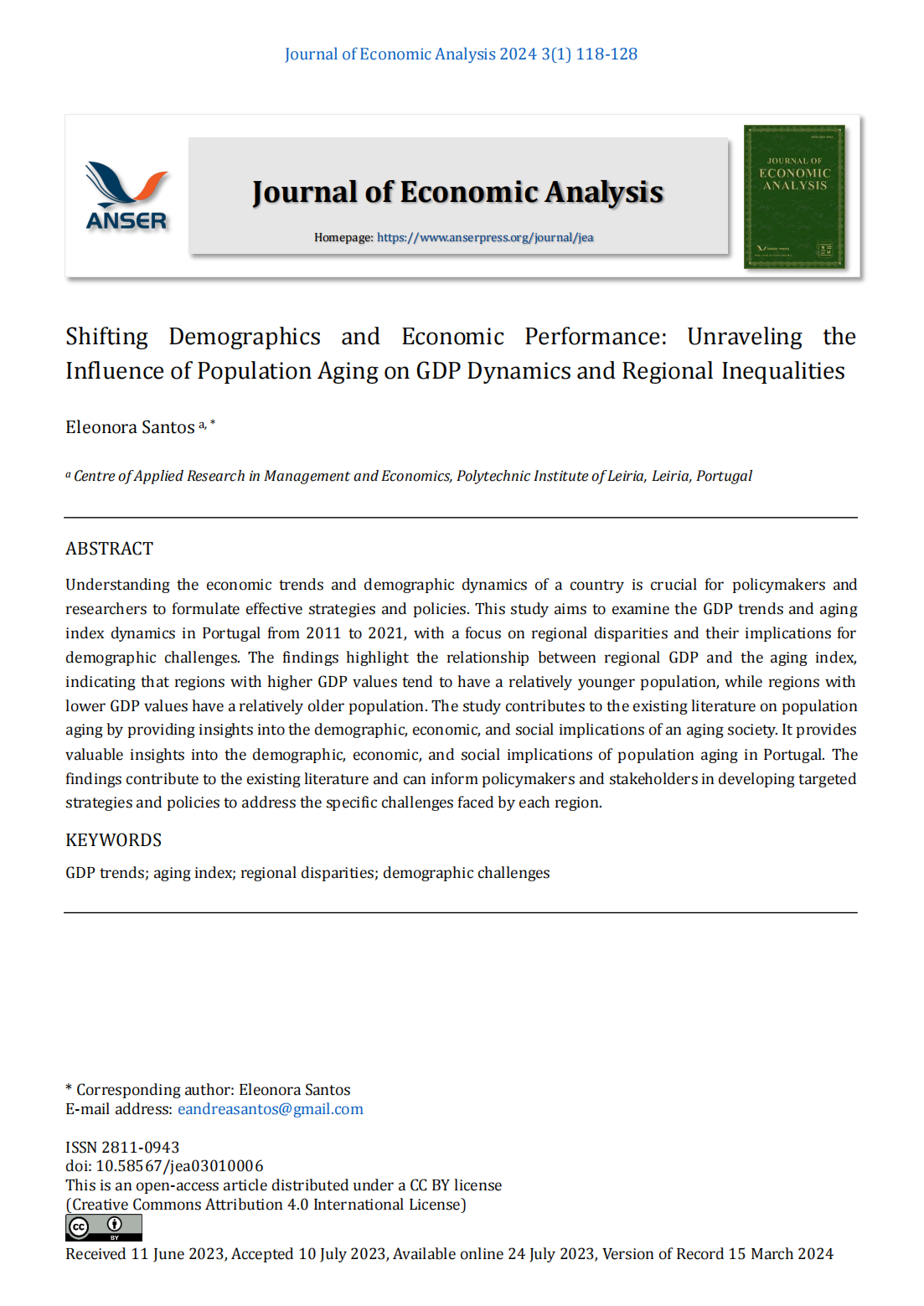Shifting Demographics and Economic Performance: Unraveling the Influence of Population Aging on GDP Dynamics and Regional Inequalities
DOI:
https://doi.org/10.58567/jea03010006Keywords:
GDP trends; aging index; regional disparities; demographic challengesAbstract
Understanding the economic trends and demographic dynamics of a country is crucial for policymakers and researchers to formulate effective strategies and policies. This study aims to examine the GDP trends and aging index dynamics in Portugal from 2011 to 2021, with a focus on regional disparities and their implications for demographic challenges. The findings highlight the relationship between regional GDP and the aging index, indicating that regions with higher GDP values tend to have a relatively younger population, while regions with lower GDP values have a relatively older population. The study contributes to the existing literature on population aging by providing insights into the demographic, economic, and social implications of an aging society. It provides valuable insights into the demographic, economic, and social implications of population aging in Portugal. The findings contribute to the existing literature and can inform policymakers and stakeholders in developing targeted strategies and policies to address the specific challenges faced by each region.
References
Anderson, G. F., & Hussey, P. S. (2000). Population Aging: A Comparison Among Industrialized Countries: Populations around the world are growing older, but the trends are not cause for despair. Health affairs, 19(3), 191-203. https://doi.org/10.1377/hlthaff.19.3.191
Bloom, D. E., Canning, D., & Sevilla, J. (2004). The effect of health on economic growth: a production function approach. World development, 32(1), 1-13. https://doi.org/10.1016/j.worlddev.2003.07.002
Brunow, S., & Hirte, G. (2006). Age structure and regional economic growth. Jahrbuch für Regionalwissenschaft, 26, 3-23. https://doi.org/10.1007/s10037-005-0075-4
Choi, K. H., & Shin, S. (2015). Population aging, economic growth, and the social transmission of human capital: An analysis with an overlapping generations model. Economic modelling, 50, 138-147. https://doi.org/10.1016/j.econmod.2015.05.015
Dostie, B. (2011). Wages, productivity and aging. De Economist, 159(2), 139-158. https://doi.org/10.1007/s10645-011-9166-5
Ferreira, D. C., Caldas, P., & Marques, R. C. (2021). Ageing as a determinant of local government performance: myth or reality? the Portuguese experience. Local Government Studies, 47(3), 475-497. https://doi.org/10.1080/03003930.2021.1904397
Fonseca, M. L. (2008). New waves of immigration to small towns and rural areas in Portugal. Population, space and place, 14(6), 525-535. https://doi.org/10.1002/psp.514
Gerpott, F. H., Lehmann-Willenbrock, N., & Voelpel, S. C. (2017). A phase model of intergenerational learning in organizations. Academy of Management Learning & Education, 16(2), 193-216. https://doi.org/10.5465/amle.2015.0185
Ilmarinen, J. (2001). Ageing workers in Finland and in the European Union: their situation and the promotion of their working ability, employability and employment. The Geneva Papers on Risk and Insurance. Issues and Practice, 26(4), 623-641. https://www.jstor.org/stable/41952603
Johansson, T. (2008). Municipal contracting out: Governance choices, misalignment and performance in Swedish local government. Financial accountability & management, 24(3), 243-264. https://doi.org/10.1111/j.1468-0408.2008.00452.x
Lai, S. L., & Yip, T. M. (2022). The role of older workers in population aging–economic growth nexus: evidence from developing countries. Economic Change and Restructuring, 55(3), 1875-1912. https://doi.org/10.1007/s10644-021-09370-4
Lee, R., & Mason, A. (2010). Fertility, human capital, and economic growth over the demographic transition. European Journal of Population= Revue Europeenne de Demographie, 26(2), 159. https://doi.org/10.1007/s10680-009-9186-x
Lindeboom, M., & Kerkhofs, M. (2009). Health and work of the elderly: subjective health measures, reporting errors and endogeneity in the relationship between health and work. Journal of Applied Econometrics, 24(6), 1024-1046.
Liu, S., & Fidel, R. (2007, December). Managing aging workforce: Filling the gap between what we know and what is in the system. In Proceedings of the 1st international conference on Theory and practice of electronic governance (pp. 121-128). Available at https://dl.acm.org/doi/abs/10.1145/1328057.1328084
Maestas, N., & Zissimopoulos, J. (2010). How longer work lives ease the crunch of population aging. Journal of Economic Perspectives, 24(1), 139-160. https://doi.org/10.1257/jep.24.1.139
Mamun, S. A. K., Rahman, M. M., & Khanam, R. (2017, November). Ageing population and economic growth nexus in Bangladesh: evidence from an endogenous growth model. In 1st International Conference on Energy, Finance and the Macroeconomy Book of Abstracts (ICEFM-2017). Montpellier Business School. Available at https://research.usq.edu.au/item/q4955/ageing-population-and-economic-growth-nexus-in-bangladesh-evidence-from-an-endogenous-growth-model
Mamun, S. A. K., Rahman, M. M., & Khanam, R. (2020). The relation between an ageing population and economic growth in Bangladesh: Evidence from an endogenous growth model. Economic Analysis and Policy, 66, 14-25. https://doi.org/10.1016/j.eap.2020.02.001
Maresova, P., Javanmardi, E., Barakovic, S., Barakovic Husic, J., Tomsone, S., Krejcar, O., & Kuca, K. (2019). Consequences of chronic diseases and other limitations associated with old age–a scoping review. BMC public health, 19, 1-17. https://doi.org/10.1186/s12889-019-7762-5
Milhana, U. L., Nufile, A. A. M., & Mustafa, A. M. M. (2020). Ageing Population and Economic Growth Nexus In Sri Lanka. Sri Lanka Journal of Population Studies, 21(2), 49-57.
Oliveira, M. J. L. D. (2022). Demographic dividend: evidence from Portugal at a regional level (Doctoral dissertation). Available at https://repositorium.sdum.uminho.pt/handle/1822/79110
Peri, G. (2016). Immigrants, productivity, and labor markets. Journal of economic perspectives, 30(4), 3-30. https://doi.org/10.1257/jep.30.4.3
Pham, T. N., & Vo, D. H. (2021). Aging population and economic growth in developing countries: a quantile regression approach. Emerging Markets Finance and Trade, 57(1), 108-122. https://doi.org/10.1080/1540496X.2019.1698418
Singh, S., Thomas, N., & Numbudiri, R. (2021). Knowledge sharing in times of a pandemic: An intergenerational learning approach. Knowledge and Process Management, 28(2), 153-164. https://doi.org/10.1002/kpm.1669
Skans, O. N. (2008). How does the age structure affect regional productivity?. Applied Economics Letters, 15(10), 787-790. https://doi.org/10.1080/13504850600749123
Storper, M., & Scott, A. J. (2009). Rethinking human capital, creativity and urban growth. Journal of economic geography, 9(2), 147-167. https://doi.org/10.1093/jeg/lbn052
Watson, A. W., Taheri, B., Glasgow, S., & O’Gorman, K. D. (2018). Branded restaurants employees’ personal motivation, flow and commitment: The role of age, gender and length of service. International Journal of Contemporary Hospitality Management. https://doi.org/10.1108/IJCHM-02-2017-0075
White, M. (2012). Older employees under pressure? Theorizing reasons for declining commitment. Work, employment and society, 26(3), 447-463. https://doi.org/10.1177/0950017012438578

Downloads
Published
How to Cite
Issue
Section
License
Copyright (c) 2024 Eleonora Santos

This work is licensed under a Creative Commons Attribution 4.0 International License.



